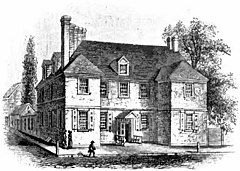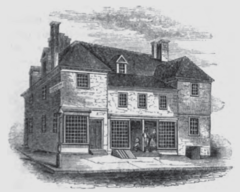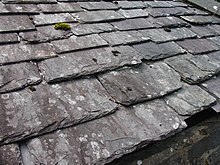The Slate Roof House was a mansion that stood on 2nd Street north of Walnut Street in Philadelphia, Pennsylvania, from about 1687 until its demolition in 1867. Built for Barbadian Quaker merchant Samuel Carpenter, the house occupied a small hill overlooking the Delaware River. It was built of brick]in the Jacobean style with its façade featuring two projecting wings that flanked a recessed central entrance. The house was notable for its large size as well for its slate roof, which was a rarity in early Philadelphia.
History
For two years (1699-1701), during his second visit to America, William Penn rented the house for use as a city residence while maintaining his country house at Pennsbury Manor in Bucks County, Pennsylvania. It was at the Slate Roof House that he wrote and issued his "Charter of Privileges," a progressive framework for Pennsylvania’s government that became the model for the United States Constitution and is still the basis of free governments all over the world.
James Logan, the secretary of the Proprietary after Penn returned to England, later lived in the Slate Roof House. He administered the colony of Pennsylvania from there between 1701 and 1704.
In later years, the house was the temporary abode of John Adams, John Hancock, and many other distinguished members of the First Continental Congress, and also of Baron Johann de Kalb, who fell, fighting for American independence, at the Battle of Camden. It was the death site for General Charles Lee and for General John Forbes, second in command, and afterwards successor to General Edward Braddock.
The Slate Roof House was altered for commercial use in the 18th century and became dilapidated during the 1800s. Despite protests from historians, the house was razed in 1867. It was replaced by a large Victorian commercial structure that stood until 1976.
In 1982, an urban courtyard called "Welcome Park" was built on the site. The park features William Penn’s plan of the city of Philadelphia laid out in slate and marble, as well as a bronze model of the house. A miniature version of the statue of Penn that crowns Philadelphia City Hall stands on a pedestal in the center. The park also features a timeline of Penn’s life on the enclosing wall. Welcome Park was named after Penn's ship, Welcome, which brought Penn and over one hundred passengers, mostly Quakers, to America in 1682.
The site is a small park with pattern brick work, a few benches, some trees and a statue of Penn by Alexander Milne Calder.[1]
See also
Sources
- Watson's Annals of Philadelphia and Pennsylvania, 1857
- Harry Kyriakodis, Philadelphia's Lost Waterfront (The History Press, 2011), at 91, 99.
- Frommer's Philadelphia Walking Tour
References
- "Historic Philadelphia Tour: Welcome Park". www.ushistory.org. Retrieved 13 February 2018.
External links
- Welcome Park
- "The Slate Roof House" at the Historical Society of Pennsylvania
https://en.wikipedia.org/wiki/Slate_Roof_House
A slater, or slate mason,[1] is a tradesperson who covers buildings with slate.[2]
Tools of the trade
The various tools of the slater's trade are all drop-forged.[3]
The slater's hammer is forged in one single piece, from crucible-cast steel, and has a 12-inch (30 cm) leather handle. It consists of a claw for drawing nails, a sheer edge for cutting slate, and a head with a sharp point at one end for punching holes in slate and with a hammer head at the other.[3][4]
The ripper is also forged from crucible-cast steel and is 24 inches (60 cm) long. It consists of a blade and a hook, and is used for removing broken slate.[3] The hook can be used to cut and remove slating nails.[5]
The slater's stake is T-shaped. The vertical bar of the "T" is pointed to allow it to be driven into a rafter or other woodworking surface. The horizontal bar of the "T" is used to support slates whilst working on them (cutting, punching, or smoothing) with other tools. The long bar of the stake can also be used as a straight edge for marking.[3][4]
The zax (also called a sack or sax[6]) is a hand tool for cutting, trimming, and punching nail holes in slate. It consists of a heavy rectangular knife blade with a large point, of square cross section, protruding from the poll (or butt). The blade edge is used to split slate, while the point is used to pierce square holes for mounting the slate on the roof (with square copper nails) or making a series of small holes marking a line where the slate is broken over a slater's iron. The tool is mounted to a laterally offset handle to protect the user's hand from sharp slate chips.[citation needed]
References
- Ripley, George; Dana, Charles Anderson (1862). "Slate". The New American Cyclopaedia: a popular dictionary of general knowledge. New York: D. Appleton and Company. p. 695.
Further reading
- Peter Mytton-Davies (1988). Practical Guide to the Repair and Maintenance of Houses. Spon Press (UK). pp. 117–118. ISBN 1850320160. — further information about slater's tools
https://en.wikipedia.org/wiki/Slater
purple
|
slate[1]
|
green
|
Slate gray is a gray color with a slight azure tinge that is a representation of the average color of the material slate. As a tertiary color, slate is an equal mix of purple and green pigments.[2][3]
Slaty, referring to this color, is often used to describe birds.
The first recorded use of slate gray as a color name in English was in 1705.[4]
Variations
Light slate gray
| Light slate gray | |
|---|---|
| Hex triplet | #778899 |
| sRGBB (r, g, b) | (119, 136, 153) |
| HSV (h, s, v) | (210°, 22%, 60%) |
| CIELChuv (L, C, h) | (56, 19, 239°) |
| Source | X11 |
| ISCC–NBS descriptor | Grayish blue |
| B: Normalized to [0–255] (byte) | |
Displayed at right is the web color light slate gray.[5]
Dark slate gray
| Dark slate gray | |
|---|---|
| Hex triplet | #2F4F4F |
| sRGBB (r, g, b) | (47, 79, 79) |
| HSV (h, s, v) | (180°, 41%, 31%) |
| CIELChuv (L, C, h) | (31, 14, 192°) |
| Source | X11 |
| ISCC–NBS descriptor | Dark bluish green |
| B: Normalized to [0–255] (byte) | |
Displayed at right is the web color dark slate gray.[6]
In human culture
Computers
- The exterior shells of supercomputers are often colored various shades of slate gray.
- The iPhone 5 and the iPad Mini comes in a Dark slate gray colored aluminum body contrasted with black.
- Western Electric used the term SLATE for the color instead of gray in their 25-pair (and multiples) cable for pairs 5-10-15-20-25.
Transportation
- The S New York City Subway service bullet, used in three out of the system's 28 services, is colored slate gray.
Military
- The Fleet Air Arm aircraft Temperate Day Scheme in the World War Two was Dark Slate Grey over Extra Dark Sea Grey on top sides and Sky on undersides. This scheme was referred as "slime over sludge".
See also
References
- "Dark slate gray". ColorHexa.com.









No comments:
Post a Comment